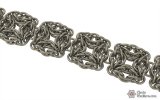What would you call this chain if the furthest rings aren't used, and the middle of the three layered rings were collapsed into just one ring? To explain what I'm trying to ask, I'll list the numbers of rings in each position as I see them in this chain starting at the tether, and do the same for the thing I'm asking about.
The tether of box drops consists of two parallel rings, connected to three rings splayed out in a manner where each is perpendicular to the tether. From the flat edge outward to the points, there are two rings (connected to the straight edge's splayed ring and the center splayed ring) that sandwich two more rings (connected to the tether by the center and pointy edge splayed rings) which in turn sandwich two parallel rings, connected to the tether only by the pointy edge's splayed ring. Then there are three splayed rings in much the same fashion, connecting to the next tether. The cell is repeated without a 180° rotation.
What I'm trying to ask about has no real pointy edge. It does have a double ring tether like you show here, and also has the splayed three rings connecting the tethering rings to the center of the cell. But the two parallel rings on the pointy edge are forgone, and the two rings that would otherwise sandwich those missing rings are instead made into just one. So that means that you'd have 2 rings for the tether, 3 splayed rings, three parallel rings with the middle of those three being offset, 3 splayed rings, and two rings for the next tether.
I ask because I did it and I made a fairly nice square out of it, but my aspect ratio was not great™ forcing me to stretch my jump rings a bit. I was going somebody knew the optimal AR for the square made of this weave I've described. I went ahead and added a spacer ring into each tether, and then linked the edges inside the square to keep the overall shape of the piece square instead of rhombus shaped.
The tether of box drops consists of two parallel rings, connected to three rings splayed out in a manner where each is perpendicular to the tether. From the flat edge outward to the points, there are two rings (connected to the straight edge's splayed ring and the center splayed ring) that sandwich two more rings (connected to the tether by the center and pointy edge splayed rings) which in turn sandwich two parallel rings, connected to the tether only by the pointy edge's splayed ring. Then there are three splayed rings in much the same fashion, connecting to the next tether. The cell is repeated without a 180° rotation.
What I'm trying to ask about has no real pointy edge. It does have a double ring tether like you show here, and also has the splayed three rings connecting the tethering rings to the center of the cell. But the two parallel rings on the pointy edge are forgone, and the two rings that would otherwise sandwich those missing rings are instead made into just one. So that means that you'd have 2 rings for the tether, 3 splayed rings, three parallel rings with the middle of those three being offset, 3 splayed rings, and two rings for the next tether.
I ask because I did it and I made a fairly nice square out of it, but my aspect ratio was not great™ forcing me to stretch my jump rings a bit. I was going somebody knew the optimal AR for the square made of this weave I've described. I went ahead and added a spacer ring into each tether, and then linked the edges inside the square to keep the overall shape of the piece square instead of rhombus shaped.


